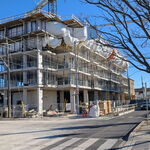Bordercollie
Senior Member
I'm sure people can travel between cars on the lower level.They do look nice. Interesting that they seem to be a dinning car on the lower level and have regular seating on the upper. It is also interesting that, unlike Amtrak's Superliners, they don't allow travel between coaches on the upper level. I am guessing they are making each car self contained to remove the need to travel through the train. I assume that could be a modification though for a different customer.
I don't think the Skyline (and Park) cars are VIA's biggest issue on their long distance trains. If they are going to continue to offer long distance service, what they really need is new sleepers.
Why do people need to travel between cars on both levels?(If that's what you meant?).
Instead of dining on the lower floor they could be bunks for sleeping. Or on the top with skylights would be nice. Watch the stars while you sleep.





